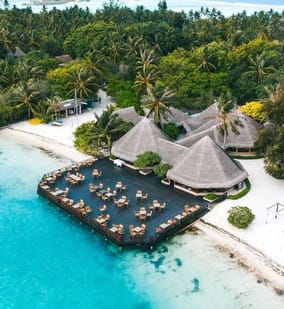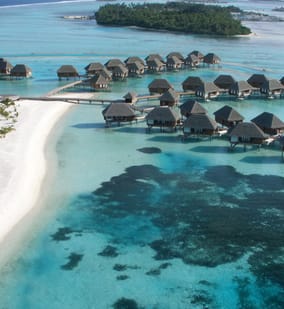The Maldivian culture when seen through its music and dance and its art and craft reveal the journey it has taken through time.
One sees the obvious influences of culture of South Asian, elements of Malaysian and Indonesian culture, Arab and East Africa culture as well.
At most celebrations in Maldives you will find a blending of tradition and modern entertainment folk dances. Music using drums and wooden instruments may be followed by modern jazz or pop music.
Music and Dance
The traditional songs and dance that we see and hear recent days are just a small part of what our ancestors performed and enjoyed. The modernisation process has unfortunately buried many of those in the sands of time. Below are some of the dances we know today.
Bandiya Jehun, a traditional dance performed only by women is said to be an adaptation of the Indian pot dance. The dance is accompanied by a small band consisting of singers and a number of musical instruments including drums and harmonica. The young ladies swing their bodies in formation as they tap out a beat on their metal water pots in accompaniment to music and song.
Bolimalaafaiy Neshun, the dance comes from the old tradition of women offering gifts to the sultan on special occasions such as Eid festival. The gifts are kept in a wooden container intricately decorated with lacquer known as the "Kurandi Malaafaiy". The Malaafaiy is covered in a piece of colourful silk cloth.
The women taking part in the dance also wear equally bright-coloured dresses. The dancers in a group may number as many as 24. They dance and sing to the tune of music expressing national sentiments.
Bodu Beru, perhaps the most commonly known and most widely performed music and dance today, bodu beru originated from East Africa. Traditionally a men’s performance the troupe consists of three drummers, lead singer and a chorus of ten to fifteen men. The songs vary in mood and rhythm.
Most songs begin slow and increase in tempo. One, two or three dancers from the group start to dance as the song progresses. The dancers fling their arms and legs and sway to the beat as the music reaches a crescendo.
It is quite common for the audience to join in with the dancers. Bodu Beru is the most commonly practised traditional music in the country today and are enjoyed by everyone, young and old.
Gaa Odi Lava was born during the reign of Sultan Mohamed Imadudeen I (1620-1648AD). The Sultan wanted to build a breakwater around Male’ in an effort to defend the island. Corals were harvested from the many reefs around the capital for this purpose. When each boat carrying coral stones completed their task they paid a ceremonial visit to the Sultan singing songs and dancing to express their happiness.
These dances and the accompanying songs eventually became known as Gaa Odi Lava. (Gaa meaning stone and Odi meaning boat) Gaa Odi Lava continued to be performed as an expression of satisfaction marking the completion of major community works.
Dhandi Jehun is another form of entertainment which is well known throughout the country. This is mostly performed to celebrate special events such as Eid and other national occasions.
Thaara was introduced to the Maldives by Gulf Arabs who came here in the mid 17TH century. Thaara meaning Tambourine, is performed by twenty two people seated in two parallel rows facing each other.
It is a type of music that has a semi religious touch, and is distinct to men only. In Thaara, there is both singing and dancing. The traditional Thaara songs were in Arabic.
Art and Craft
The historical and maritime links with South Asia, South East Asia and the Arabs are quiet obvious in Maldivian culture. Even with rapid development and modernisation which has brought in new influences, strong elements of these links remain vividly engraved in the local culture. These elements combine with indigenous local culture to create a distinct, sophisticated style of art and craft in the Maldives.
The Maldivian ‘Dhoni’ can perhaps be taken as a symbol of the calibre of the Maldivian craftsmanship; shaped, crafted and evolved to suit the needs of the people who use them, and made to withstand the uncertainties of the wind and waves.
With long, slender elegant curving prows, the Maldivian Dhoni is a work of art, an outstanding example of craftsmanship and execution. It is amazing that these boats were made without any written plans, the chief carpenter or Maavadi brings out the shape and symmetry using his eyes and experience. The skill of boat building has been handed over from generation to generation.
Boats are central to Maldivian life, from earning a living, transporting produce to travel from one island to another. Hence the development of these vessels must have played a pivotal role in improving life in the unique marine environment of the Maldives. In the 13TH century the planks of the Dhoni were held together by coir.
By the 16th century wooden pegs were in use which then gave way to iron nails. The sail has seen similar changes; a square sail made from coconut fronds gave way to a triangular lateen sail which is now used only as a backup in case of engine failure.
Although the basic style and design of the Dhoni has remained the same, the technique of boat building has also changed tremendously.
Thundu Kunaa, throughout the country women weave beautiful and detailed reed mats, the most impressive of which is the Thundu Kunaa. The mats are woven using Hau (reeds). The entire production process is carried out by women.
After the Hau is dried it is stained with natural dyes which vary from fawn to black and yellow. The rush is then trimmed and the strips are then woven on a horizontal loom. The finished product is beautifully smooth on the upper surface with abstract designs. The complexity of the designs varies according to the talent and imagination of the weaver.
Lacquered boxes and ornaments, Liye laajehun, as it is known in Dhivehi is perhaps the country’s most distinct craft. The craftsmen on Thulhaadhoo in Baa Atoll are renowned for their skill in the art of Liye laajehun. Pieces of wood are lathed to produce the desired shapes; a vase, a trinket holder or the Maaloodh foshi, large round plates with lids, traditionally used during feast and festivals. Each piece is lacquered in strands of red, black and yellow resin and abstract sketches are lightly curved into the black strands.
Festive Maldives
Maldivian festivals and holidays celebrate religious and national festivals and events. While the religious and some of the national holidays are celebrated following the Islamic lunar calendar, some of the national holidays such as the Independence Day are based on the western calendar.
Ramadan is the longest and perhaps the most important festival in the Maldives. Ramadan is the ninth month of the Muslim calendar, the fasting month and one of the most outstanding months in terms of how patterns of life and other aspects change from the norm.
The month commemorates the revelation of Quran and all Muslims fast during the day abstaining from all food and drink. The fast is broken at sunset and a wondrous spread of food and drink is prepared in each household to break the fast. The atmosphere during the month of Ramadan is pious as well as festive.
Kuda Eid or Eid ul-Fitr as it is known in Arabic is the celebration to mark the end of Ramadan. The day starts with the Morning Prayer and by noon each house has prepared a feast to mark the day.
Family, friends, neighbours and total strangers are invited to take part in the recitation of prayers and to enjoy the feast. In the afternoon different events are held to mark the day. Today traditional activities go hand in hand with sports and other community celebrations.
Hajj and Bodu Eid, Muslims are required to perform the pilgrimage to Mecca known as Hajj once in their lifetime, if they can afford the journey. The 9TH day of the month of Zul Hijja in the Lunar Calendar is the day of Hajj. The 10TH is the Eid ul-Al’haa, the Festival of Sacrifice.
The Day of Hajj, Bodu Eid and the three days that follow are national holidays and are the longest annual public holiday in the Maldives. It is a time when people travel to their islands with family and friends making it the most celebrated festival in the country. The day of Hajj is a day of prayer while Bodu Eid is a day of celebration. Feasts are enjoyed in all homes and several activities are held in all communities to celebrate the day.
National Day, on 1st July 1573, Muhammed Thakurufaanu defeated the occupying Portuguese forces. The National Day honours Muhammed Thakurufaanu and celebrates the liberation of the country four centuries ago. The National Day is marked on the 1st of Rabeeul Awwal; the first day of the third month in the Islamic Calendar.
Republic Day, the Republic Day celebrates the anniversary of the Second Republic proclaimed on the 11TH of November 1968. Special meetings and celebrations are held throughout the country.
Independence Day, the Independence Day on 26TH of July is the biggest national event in terms of the scale of formal celebrations and marks the anniversary of independence from the British in 1965.
During the last few years the official celebration of the Independence Day has been held at the Republic square. Hundreds of school children and members of different communities take part in the event. The President and foreign dignitaries attend the event as well. The Independence Day is also celebrated throughout the country at island and community levels.
Maldivian Food
If you guessed that the most important ingredient in Maldivian recipes is tuna, you guessed right. From the traditional fish broth that is served daily at homes to savouries and snacks, from curries to delightful accompaniments, tuna and grated coconut are key ingredients. What may surprise you though, is how different they taste in spite of their common ingredient.
Local vegetables and fruits have also been part of the local cuisine. Pumpkin, breadfruit, plantains and gourds are used to make mouth watering delicacies. Like everything else food has also been heavily influenced by modernisation.
Today imported vegetables and meats form part of the daily diet throughout the country. Agriculture has taken in these changes into account and many vegetables such as tomatoes and eggplants which were not grown before have been introduced and widely grown.
The most commonly seen local eatery is the ‘sai hotaa’, a café that serves tea and a wide range of savouries throughout the day and meals during lunch and dinner time.
Quick guide to cuisine
Gulha: Fish and scraped coconut mixture wrapped in a ball of pastry and deep fried.
Kavaabu: Deep-fried fish rissole.
Kulhi boakibaa: Fish cake.
Fihunu mas: Fish brushed with chilli paste and barbecued over hot coals.
Suji: A thick sweet drink made with semolina, coconut milk, sultanas, nuts and a dash of cinnamon and cardamom.
Garudhiya: Part of the traditional staple diet, Garudhiya is a fish broth eaten with rice. On its own it appears bland but the taste is enhanced with the complete accompaniments that include the traditional chilli paste, lonu mirus, chilies and onions. Garudhiya is also eaten with boiled breadfruit and taro.











